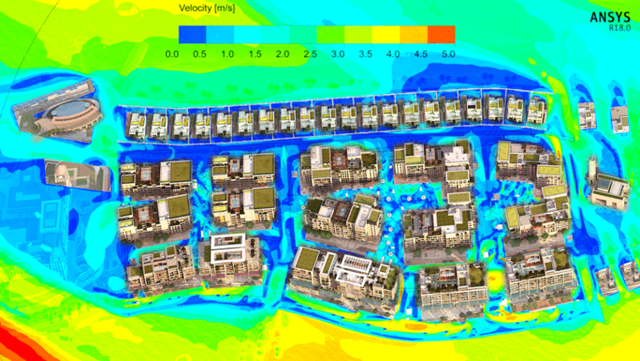Delivering Climatised Outdoor Retail Experience in The Gulf (Dalia Khalil, DAR)
The microclimate study for Doha’s Gewan Island, one of the world's largest open-air retail areas, was presented during CIBSE Building Simulation Awards 2023, showing how simulation tools can aid architects and engineers in designing comfortable urban environments tailored to the unique climate and conditions of the Gulf area.
The implementation of an outdoor climate control system along Gewan Island’s central spine area promises to create a temperature-controlled environment, mitigating the adverse effects of Doha’s characteristic severe weather across all seasons.
The outdoor climate control system was developed since early design stages using advanced macro scale simulation tools like IES and microscale coupled temperature and wind simulations in ANSYS, incorporating detailed Revit models encompassing all architectural, site, and landscape elements. The microclimate study aimed to scrutinise the performance of the proposed outdoor cooling strategy amidst the challenging Doha weather, validating the suitability of the VAC design in achieving prescribed comfort thresholds, notably Standard Effective Temperature (SET) values below 30 with a maximum allowable 300 unmet hours. The study also focused on improving how air flows around Gewan Island to maintain this comfort.

Given the challenging climatic conditions typical of Doha, a comprehensive microclimate strategy was devised to determine and optimise the cooling requirements necessary to meet the targeted comfort conditions. This strategy blends passive environmental control techniques such as wind barriers and landscape features with targeted mechanical cooling methods strategically located in basement areas to distribute cooled air at optimised flow rates and temperatures. The cold air is dispersed through a network of diffusers incorporated within shading columns, strategically positioned totems, and landscape planters throughout the central spine zone and Waterfront Promenade; this approach ensures a uniformly comfortable outdoor climate. This climate optimisation is achieved without compromising the functional integrity of the spaces or structural elements, thereby exemplifying a holistic approach to comfortable urban design.

The wind simulations on the ANSYS CFD suite underwent multiple iterations to ensure the robustness of the outdoor cooling system design. Throughout each iteration, the collected data was utilised to refine and optimise the efficiency of the air distribution system, thereby maintaining the prescribed comfort conditions within the designated areas. A key obstacle encountered during this process revolved around the prevention of cooled air from escaping from the designated zones, exacerbated by the effects of hot air winds. To address this challenge, modifications were implemented, including adjustments to the quantity and placement of diffuser units, as well as reconfigurations of landscape elements to enhance containment efficacy.


As a conclusion, the objective of achieving outdoor comfort conditions at one of the world's largest open-air retail areas in the Gulf region was successfully attained for 97% of the year. This study serves as a compelling demonstration of the efficacy of simulation tools when employed from the project's inception. Such tools empower architects, landscape designers, and mechanical engineers to gain a deeper understanding of the intricate dynamics involved in creating optimal outdoor environments, leading to enhanced collaboration and ultimately, the realisation of exceptional urban spaces.
